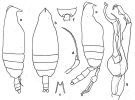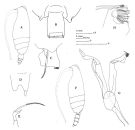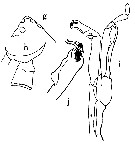|
|
 |
Fiche d'espèce de Copépode |
|
|
Calanoida ( Ordre ) |
|
|
|
Clausocalanoidea ( Superfamille ) |
|
|
|
Scolecitrichidae ( Famille ) |
|
|
|
Scottocalanus ( Genre ) |
|
|
| |
Scottocalanus terranovae Farran, 1929 (F,M) | |
| | | | | | | Syn.: | ? Scottcalanus helenae (M): Tanaka, 1961 a (p.145) | | | | Ref.: | | | Farran, 1929 (p.209, 251, figs.F,M); Sewell, 1948 (p.553); Vervoort, 1965 (p.57, Rem.); Park, 1983 (p.198, 200, 210); Bradford & al., 1983 (p.116, 119, Rem.F,M, figs.F,M) |  issued from : G.P; Farran in British Antarctic (\"Terra Nova\") Expedition, 1910. Natural History Reports. Zoology. Vol. VIII; Crustacea, 1929. [p.251, Fig.18]. Female: a, habitus (lateral view); b, idem (dorsal view); c, rostrum (anterior view); d, fifth foot. Male: e, habitus (lateral view); f, 4th and 5th thoracic segment and first genital segment (dorsal view); g, fifth feet.
|
 Issued from : J.M. Bradford, L. Haakonssen & J.B. Jillett in Mem. N. Z. Oceanogr. Inst., 1983, 90. [p.120, Fig.74]. Female: A, habitus (lateral left side); B, genital segment (dorsal); C, genital segment and P5 (lateral left side); D, rostrum; E, P5 (other specimen). Male: F, habitus (lateral left side); G, P5; H, terminal part of left P5 exopod.
Female: - Posterolateral corners of last thoracic segment rounded in lateral view, but constricted in dorsal view and appearing like sharp spines. - head with triangular crest. - Rostrum with short rami and apical projections shorter than excavation. - Genital segment as long as following three segments, with genital protuberance. - P5 with terminal seta twice as long as leg, reaches distal end of urosomal segment 3. Male: - Rostrum as in female. - Fusion line between pediger segments 4 and 5 visible. - Right P5 endopod reaches beyond exopodal segment 1; exppodal segment 2 curved, exopodal segment 3 very small. Left P5 endopod shorter than exopodal segment 1; exopod at least 2-segmented.
|
 Issued from : O. Tanaka in Publ. Seto Mar. Biol. Lab., IX, 1, 1961 a. [p.144, Fig.107, g-j]. As Scottcalanus helenae Male. g, forehead (lateral); h, last thoracic segment and 1st and 2nd urosomal segments (lateral); i, P5; j, distal segment of left P5. - Last thoracic segment rather broadly rounded ; ventral margin of the segment much inflated when viewved from the side - Abdomen 5-segmented ; segments and caudal rami in the proportional lengths 18 : 24 : 23 : 21 : 7 : 7 = 100. Distal margin of the 2 nd to 4th segments fringed with fine teeth. segments. - A1 extends to the middle of the 4th abdominal segment. - Serration on the terminal spine of the exopod of P2 to P4 are more in number than those of the corresponding legs of the female [in S. helenae]. - Endopod of right leg of is long and curved towards the exopod, reaching about to the middle of the 2 nd segment of the exopod. Endopod of the left leg P5 short, about ½ the length of the 1st segment of the exopod of the same leg. 2 nd segment of the exopod of the left leg P5 dilated much on the inner margin. The 3rd segment of the exopod is represented by 2 curved stout spines, a pad of stiff hairs, and a leaf-like lamellous process with serrations on the distal end. For Tanaka, the male agrees well with the description and figures of S. helenae given by A Scott. According to Farran (1936) the male of S. lonsispinus has the 5th thoracic segment with a small spine at its distal end, and the rostral spine which differs from that of the female.
| | | | | Ref. compl.: | | | Björnberg, 1973 (p.333, 389); Heinrich, 1990 (p.17, 22: Rem.?); Lan Y.-C. & al., 2008 (p.61, Table 1, % vs stations) | | | | NZ: | 3 | | |
|
Carte de distribution de Scottocalanus terranovae par zones géographiques
|
| | | | | | | Loc: | | | China Seas (East China Sea, inW. Zhang & al., 2010), 25°30'N-123°E, SW Pacif., New Zealand, ? SE Pacif. (tropical), N Chile | | | | N: | 4 | | | | Lg.: | | | (9) F: 3,9-3,6; M: 4,2-3,6; (35) F: 3,9-3,84; M: 4,2-4,1; {F: 3,60-3,90; M: 3,60-4,20} | | | | Rem.: | La validité de l'espèce est mise en cause par certains auteurs. ? Cf. Scottocalanus thorii (M)
Voir aussi les remarques en anglais | | | Dernière mise à jour : 06/03/2017 | |
|
|
 Toute utilisation de ce site pour une publication sera mentionnée avec la référence suivante : Toute utilisation de ce site pour une publication sera mentionnée avec la référence suivante :
Razouls C., Desreumaux N., Kouwenberg J. et de Bovée F., 2005-2025. - Biodiversité des Copépodes planctoniques marins (morphologie, répartition géographique et données biologiques). Sorbonne Université, CNRS. Disponible sur http://copepodes.obs-banyuls.fr [Accédé le 03 décembre 2025] © copyright 2005-2025 Sorbonne Université, CNRS
|
|
 |
 |






